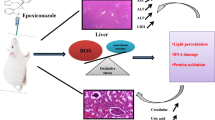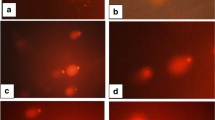Abstract
To explore the mechanism of renal toxicity induced by florfenicol (FFC), 120 chicks were randomly divided into 6 groups, 20 in each group. Except for the control group, different doses of FFC (0.15 g/L, 0.3 g/L, 0.6 g/L, 1.2 g/L, and 1.8 g/L) were added to drinking water in the other 5 groups. Five days later, blood was collected from the vein under the wing, and the complete kidneys were obtained as soon as possible, then tested the experimental indicators. The results showed that compared with control group, all doses of FFC significantly reduced the average weight gain of chicks (P < 0.05 or P < 0.01). Except for the 0.15 g/L FFC group, kidney index of chicks in the other doses of FFC groups were significantly increased (P < 0.05 or P < 0.01). The kidney tissues in all FFC groups showed obvious damage, deformities, cell atrophy, and cell gap enlargement. In addition, all doses of FFC significantly increased the contents of uric acid (UA), blood urea nitrogen (BUN), creatinine (CRE) in serum, and malondialdehyde (MDA) in renal tissue (P < 0.05 or P < 0.01), but significantly reduced the levels of glutathione (GSH), superoxide dismutase (SOD), and catalase (CAT) in renal tissue (P < 0.05 or P < 0.01). FFC significantly inhibited the mRNA and protein expression levels of nuclear factor-erythroid 2-related factor 2 (Nrf2), heme oxygenase-1 (HO-1), and nicotinamide adenine dinucleotide phosphate: quinone oxidoreductase-1 (NQO-1), and increased the mRNA and protein expression levels of p53, Caspase-3, and Caspase-6 (P < 0.05 or P < 0.01). The apoptotic rate of renal cells in all doses of FFC groups increased significantly (P < 0.05 or P < 0.01). It was concluded that FFC had a certain degree of nephrotoxicity, and with the increase of FFC concentration, the kidney injury of chicks became more and more serious. FFC promoted oxidative stress response in kidney of chicks by inhibiting the expression of related factors in Nrf2-ARE pathway. Moreover, the expression of pro-apoptotic factors was upregulated to improve the apoptosis rate of renal cells, which resulted in excessive apoptosis of renal cells and seriously affected the kidney function of chicks.






Similar content being viewed by others
References
Afifi NA, El-Sooud, Abo K (1997) Tissue concentrations and pharmacokinetics of florfenicol in broiler chickens. Br Poult Sci 38(4):425–428
Akindele AJ, Ezenwanebe KO, Anunobi CC, Adeyemi OO (2010) Hepatoprotective and in vivo antioxidant effects of Byrsocarpus coccineus Schum. and Thonn. (Connaraceae). J Ethnopharmacol 129(1):46–52
Albarakati AJA, Baty RS, Aljoudi AM, Habotta OA, Elmahallawy EK, Kassab RB, Abdel Moneim AE (2020) Luteolin protects against lead acetate-induced nephrotoxicity through antioxidant, anti-inflammatory, anti-apoptotic, and Nrf2/HO-1 signaling pathways. Mol Biol Rep 47(4):2591–2603
Al-Shahrani S, Naidoo V (2015) Florfenicol induces early embryonic death in eggs collected from treated hens. BMC Vet Res 11(1):213
Atef M, El-Gendi AY, Aziza MM, Abd El-Aty AM (2000) Pharmacokinetic properties of florfenicol in Egyptian goats. Dtsch Tierarztl Wochenschr 107(4):147–150
Awodele O, Tomoye OP, Quashie NB, Amagon KI, Ogunnowo SA (2015) Gentamicin nephrotoxicity: animal experimental correlate with human pharmacovigilance outcome. Biomed J 38(2):125–130
Balbi HJ (2004) Chloramphenicol: a review. Pediatr Rev 25(8):284–288
Bretzlaff KN, Neff-Davis CA, Ott RS, Koritz GD, Gustafsson BK, Davis LE (1987) Florfenicol in non-lactating dairy cows: pharmacokinetics, binding to plasma proteins, and effects on phagocytosis by blood neutrophils. J Vet Pharmacol Ther 10(3):233–240
Cannon M, Harford S, Davies J (1990) A comparative study on the inhibitory actions of chloramphenicol, thiamphenicol and some fluorinated derivatives. J Antimicrob Chemother 26(3):307–317
Chen Y, Sun J, Liao XP, Shao Y, Li L, Fang LX, Liu YH (2016) Impact of enrofloxacin and florfenicol therapy on the spread of OqxAB gene and intestinal microbiota in chickens. Vet Microbiol 192:1–9
de Jesus-Silva SG, de Moraes SMA, Carbonel A, Grillo Filho G, Grigório TS, Simões MJ, Cardoso RS, Fagundes DJ (2020) Heparin attenuates visceral apoptosis in a swine model of hemorrhagic shock and reperfusion injury. Ann Vasc Surg S0890-5096(20):30191–30196
Firozian F, Karami S, Ranjbar A, Azandaryani MT, Nili-Ahmadabadi A (2020) Improvement of therapeutic potential N-acetylcysteine in acetaminophen hepatotoxicity by encapsulation in PEGylated nano-niosomes. Life Sci 255:117832
Han C, Wei Y, Cui Y, Geng Y, Bao Y, Shi W (2020) Florfenicol induces oxidative stress and hepatocyte apoptosis in chicks via Nrf2 pathway. Ecotoxicol Environ Saf 191:110239
Hashish EA, Elgaml SA, El-Fattah A, Shalaby SI, Abdelaziz S (2020) beta-Amyrin supplementation ameliorates the toxic effect of glycerol in the kidney of rat model. Hum Exp Toxicol 39(7):930–937
Hassanin O, Abdallah F, Awad A (2014) Effects of florfenicol on the immune responses and the interferon-inducible genes in broiler chickens under the impact of E. coli infection. Vet Res Commun 38(1):51–58
Hu D, Zhang T, Zhang Z, Wang G, Wang F, Qu Y, Niu Y, Liu S (2014) Toxicity to the hematopoietic and lymphoid organs of piglets treated with a therapeutic dose of florfenicol. Vet Immunol Immunopathol 162(3-4):122–131
Hu D, Cao S, Zhang G, Xiao Y, Liu S, Shang Y (2017) Florfenicol-induced mitochondrial dysfunction suppresses cell proliferation and autophagy in fibroblasts. Sci Rep 7(1):13554
Ji J, Zhou X, Xu P, Li Y, Shi H, Chen D, Li R, Shi H (2019) Deficiency of apoptosis-stimulating protein two of p53 ameliorates acute kidney injury induced by ischemia reperfusion in mice through upregulation of autophagy. J Cell Mol Med 23(4):2457–2467
Kang R, Zeh HJ, Lotze MT, Tang D (2011) The Beclin 1 network regulates autophagy and apoptosis. Cell Death Differ 18(4):571–580
Kensler TW, Wakabayashi N, Biswal S (2007) Cell survival responses to environmental stresses via the Keap1-Nrf2-ARE pathway. Annu Rev Pharmacol Toxicol 47:89–116
Kitakaze T, Yuan S, Inoue M, Yoshioka Y, Yamashita Y, Ashida H (2020) 6-(Methylsulfinyl)hexyl isothiocyanate protects acetaldehyde-caused cytotoxicity through the induction of aldehyde dehydrogenase in hepatocytes. Arch Biochem Biophys 686:108329
Leung L, Kwong M, Hou S, Lee C, Chan JY (2003) Deficiency of the Nrf1 and Nrf2 transcription factors results in early embryonic lethality and severe oxidative stress. J Biol Chem 278(48):48021–48029
Lunden T, Bylund G (2000) The influence of in vitro and in vivo exposure to antibiotics on mitogen-induced proliferation of lymphoid cells in rainbow trout (Oncorhynchus mykiss). Fish Shellfish Immunol 10(5):395–404
McKellar QA, Varma KJ (1996) Pharmacokinetics and tolerance of florfenicol in Equidae. Equine Vet J 28(3):209–213
Mehdi Y, Létourneau-Montminy MP, Gaucher ML, Chorfi Y, Gayatri S, Rouissi T, Brar SK, Côté C, Ramirez AA, Godbout S (2018) Use of antibiotics in broiler production: global impacts and alternatives. Anim Nutr 4(2):170–178
Oguz F, Beytur A, Sarihan E, Oguz HK, Bentli R, Samdanci E, Kose E, Polat A, Duran ZR, Parlakpinar H, Ekinci N (2016) Protective effects of molsidomine against doxorubicin-induced renal damage in rats. Clin Invest Med 39(1):E7–E14
Olga B, Eija V, Fagerstedt KV (2003) Antioxidants, oxidative damage and oxygen deprivation stress: a review. Ann Bot 91 Spec(2):179–194
Paape MJ, Miller RH, Ziv G (1990) Effects of florfenicol, chloramphenicol, and thiamphenicol on phagocytosis, chemiluminescence, and morphology of bovine polymorphonuclear neutrophil leukocytes. J Dairy Sci 73(7):1734–1744
Picco EJ, Diaz DC, Valtorta SE, Boggi JC (2001) Chronotoxicology of florfenicol. Chronobiol Int 18(3):567–572
Quan J, Pan X, He T, Lin C, Lai Y, Chen P, Zhang Z, Yang S, Wang T, Lai Y (2018) Tumor suppressor miR-211-5p is associated with cellular migration, proliferation and apoptosis in renal cell carcinoma. Exp Ther Med 15(4):4019–4028
Refaie MM, Amin EF, El-Tahawy NF, Abdelrahman AM (2016) Possible protective effect of diacerein on doxorubicin-induced nephrotoxicity in rats. J Toxicol 2016:9507563
Shah JM, Qureshi TA, Shah T, Shah QA, Arain MA, Bhutto ZA, Saeed M, Siyal FA (2016) Impact of therapeutic and high doses of florfenicol on kidney and liver functional indicators in goat. Vet World 9(10):1135–1140
Sharma S, Baboota S, Amin S, Mir SR (2020) Ameliorative effect of a standardized polyherbal combination in methotrexate-induced nephrotoxicity in the rat. Pharm Biol 58(1):184–199
Syriopoulou VP, Harding AL, Goldmann DA, Smith AL (1981) In vitro antibacterial activity of fluorinated analogs of chloramphenicol and thiamphenicol. Antimicrob Agents Chemother 19:294–297
Ueda Y, Ohtsuki S, Narukawa N (1995) Efficacy of florfenicol on experimental Actinobacillus pleuropneumonia in pigs. J Vet Med Sci 57(2):261–265
Yang CM, Huang SM, Liu CL, Hu ML (2012) Apo-8'-lycopenal induces expression of HO-1 and NQO-1 via the ERK/p38-Nrf2-ARE pathway in human HepG2 cells. J Agric Food Chem 60(6):1576–1585
Yeligar SM, Machida K, Kalra VK (2010) Ethanol-induced HO-1 and NQO1 are differentially regulated by HIF-1alpha and Nrf2 to attenuate inflammatory cytokine expression. J Biol Chem 285:35359–35373
Zaidi SK, Hoda MN, Tabrez S, Ansari SA, Jafri MA, Shahnawaz Khan M, Hasan S, Alqahtani MH, Mohammed Abuzenadah A, Banu N (2014) Protective effect of Solanum nigrum leaves extract on immobilization stress induced changes in rat’s brain. Evid Based Complement Alternat Med 2014(4):912450
Zhang X, Xiong H, Li H, Yu L, Deng X (2011) Effects of florfenicol on LPS-induced nitric oxide and prostaglandin E(2) production in RAW 264.7 macrophages. Fundam Clin Pharmacol 25(5):591–598
Zhang Q, Zhang C, Ge J, Lv MW, Talukder M, Guo K, Li YH, Li JL (2020) Ameliorative effects of resveratrol against cadmium-induced nephrotoxicity via modulating nuclear xenobiotic receptor response and PINK1/Parkin-mediated mitophagy. Food Funct 11(2):1856–1868
Funding
This study was financially supported by Subsidized Project for Cultivating Innovative Ability of Postgraduates of Hebei province (NO.CXZZBS2019096).
Author information
Authors and Affiliations
Contributions
Wanyu Shi and Yongzhan Bao conceived and designed the study, and they rigorously revised the manuscript. Xiao Wang and Chao Han participated in the design of the experiment, conducted most of the experiments, and analyzed the results. They also co-wrote the manuscript. Yumeng Geng and Yuanyuan Wei helped collect samples and participated in the qPCR experiment. Yuqing Cui participated in the H&E, Western blot, and TUNEL experiments. All authors read and approved the final manuscript.
Corresponding authors
Ethics declarations
Conflict of interest
The authors declare that they have no conflicts of interest.
Additional information
Responsible editor: Mohamed M. Abdel-Daim
Publisher’s note
Springer Nature remains neutral with regard to jurisdictional claims in published maps and institutional affiliations.
Rights and permissions
About this article
Cite this article
Wang, X., Han, C., Cui, Y. et al. Florfenicol induces renal toxicity in chicks by promoting oxidative stress and apoptosis. Environ Sci Pollut Res 28, 936–946 (2021). https://doi.org/10.1007/s11356-020-10550-4
Received:
Accepted:
Published:
Issue Date:
DOI: https://doi.org/10.1007/s11356-020-10550-4




